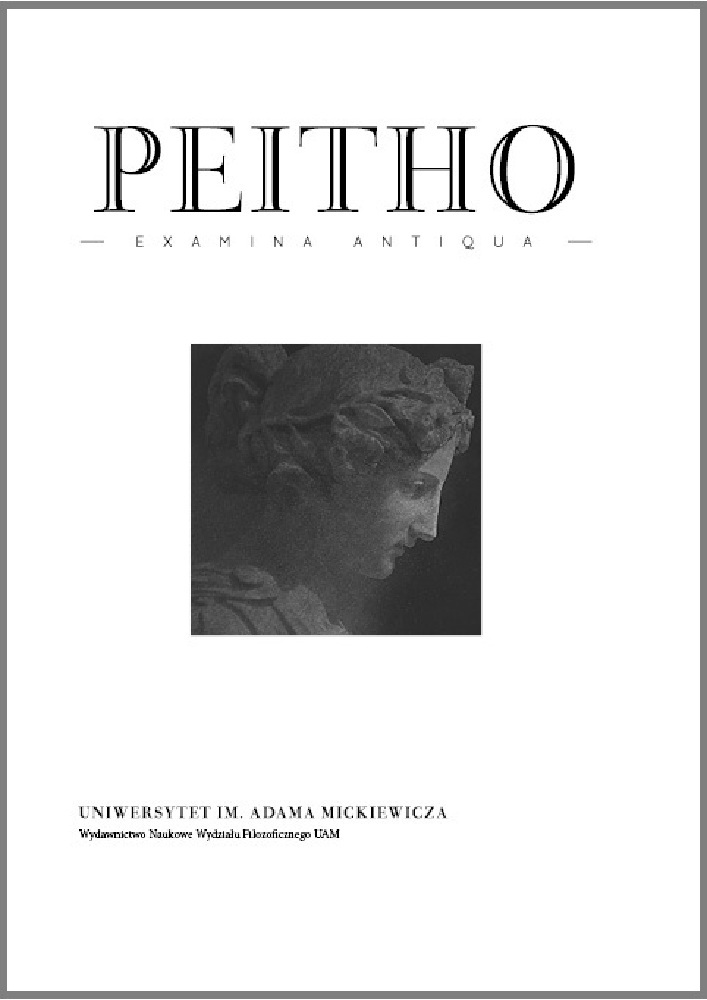Abstract
The present article is concerned with Proclus’ highly original and profoundly influential account of the symbolic function of poetry, the pedagogic as well as the hieratic value of myths and the soteriological power of allegorical interpretation. Thus, the paper begins with a brief discussion of Plato’s dismissal of poetry as μέγιστον ψεῦδος. Subsequently, Proclus’ theory of three kinds of poetry is examined, upon which attention is paid to his revolutionary idea that σύμβολα rather than μιμήματα are the tools of the highest kind of poetry. Then, Proclus’ views on the difference between Plato’s and Homer’s μυθοποιΐα are considered. While the article concludes with an analysis of Proclus’ conviction about the functional similarity of symbols in myths and those in magic rites, allegoresis is shown to have the same salvational role that Proclus ascribes to theurgy.References
Baine Harris, R., 1976 (ed.), The Significance of Neoplatonism, Norfolk.
Blönnigen, C., 1992, Der griechische Ursprung der jüdisch-hellenistischen Allegorese und ihre Rezeption in der alexandrinischen Patristik, Frankfurt am Main.
Brisson, L., 1996, Introduction à la philosophie du mythe, vol. 1: Sauver les mythes, Paris.
Buffière, F., 1956, Les mythes d’Homère et la pensée grecque, Paris.
Cardullo, L., 1985, Il linguaggio del simbolo in Proclo. Analisi filosofico-semantica dei termini symbolon/eikôn/synthêma nel Commentario alla Republica, Catania.
Chlup, R., 2012, Proclus: An Introduction, Cambridge.
Copeland, R., Struck, P.T., 2010, (ed.), The Cambridge Companion to Allegory, Cambridge.
Coulter, J.A., 1976, The Literary Microcosm. Theories of Interpretation of the Later Neoplatonists, Leiden.
Dillon, J., 1976, “Image, Symbol and Analogy: Three Basic Concepts of Neoplatonic Allegorical Exegesis”, in: Baine, Harris (1976), pp. 247–262.
Domaradzki, M., 2012, “Theological Etymologizing in the Early Stoa”, Kernos. Revue internationale et pluridisciplinaire de religion grecque antique 25, pp. 125–148.
Friedl, A.J., 1936, Die Homerinterpretation des Neuplatonikers Proklos, Würzburg.
Gallavotti, C., 1933, L’estetica greca nell’ultimo suo cultore (il neoplatonico Proclo), Torino.
Gersh, S., 2000, “Proclus’ Theological Methods: The Programme of Theol. Plat. I.4”, in: Segonds, Steel (2000), pp. 15–27.
Gersh, S., 2014, (ed.), Interpreting Proclus: From Antiquity to the Renaissance, Cambridge.
Lamberton, R., 1986, Homer the Theologian: Neoplatonist Allegorical Reading and the Growth of the Epic Tradition, Berkeley.
Lamberton, R., 2000, “Language, Text, and Truth in Ancient Polytheist Exegesis”, in: Whitman (2000), pp. 73–88.
Lesher, J.H., 1992, Xenophanes of Colophon. Fragments: A Text and Translation with a Commentary, Toronto.
Müri, W., 1976, “ΣΥΜΒΟΛΟΝ. Wort- und sachgeschichtliche Studie”, in: Müri (1976a), pp. 1–44 [repr. Beilage zum Jahresbericht über das städtische Gymnasium in Bern, Bern 1931, pp. 1–46].
Müri, W., 1976a, Griechische Studien. Ausgewählte wort- und sachgeschichtliche Forschungen zur Antike (Schweizerische Beiträge zur Altertumswissenschaft 15), E. Vischer (Hrsg.), Basel.
Pépin, J., 1976, Mythe et allégorie: Les origines grecques et les contestations judéo-chrétiennes, Paris.
Pépin, J., 2000, “Les modes de l’enseignement théologique dans la Théologie platonicienne”, in: Segonds, Steel (2000), pp. 1–14.
Pichler, R., 2006, Allegorese und Ethik bei Proklos: Untersuchungen zum Kommentar zu Platons Politeia, Berlin.
Ramelli, I., Lucchetta, G., 2004, Allegoria, vol. 1: L’età classica, Milano.
Segonds, A.Ph., Steel, C., 2000, (eds.), Proclus et la Théologie platonicienne, Leuven et Paris.
Sheppard, A., 1980, Studies on the 5th and 6th Essays of Proclus’ Commentary on the Republic, Göttingen.
Sheppard, A., 2014, “Proclus as Exegete”, in: Gersh (2014), pp. 57–79.
Struck, P.T., 2004, Birth of the Symbol: Ancient Readers at the Limits of Their Texts, Princeton.
Struck, P.T., 2010, “Allegory and Ascent in Neoplatonism”, in: Copeland, Struck (2010), pp. 57–70.
Tarrant, H., 2007, (ed.), Proclus. Commentary on Plato’s Timaeus, Vol. 1: Book I: Proclus on the Socratic State and Atlantis, Cambridge.
Tate, J., 1929, “Plato and Allegorical Interpretation”, Classical Quarterly 23, pp. 142–154.
van den Berg, R.M., 2001, Proclus’ Hymns: Essays, Translations, Commentary, Leiden.
Wehrli, F., 1928, Zur Geschichte der allegorischen Deutung Homers im Altertum, Borna und Leipzig.
Whitman, J., 1987, Allegory. The Dynamics of an Ancient and Medieval Technique, Cambridge.
Whitman, J., 2000, (ed.), Interpretation and Allegory. Antiquity to the Modern Period, Leiden.
License
Peitho provides immediate open access to its content on the principle that making research freely available to the public supports a greater global exchange of knowledge.
